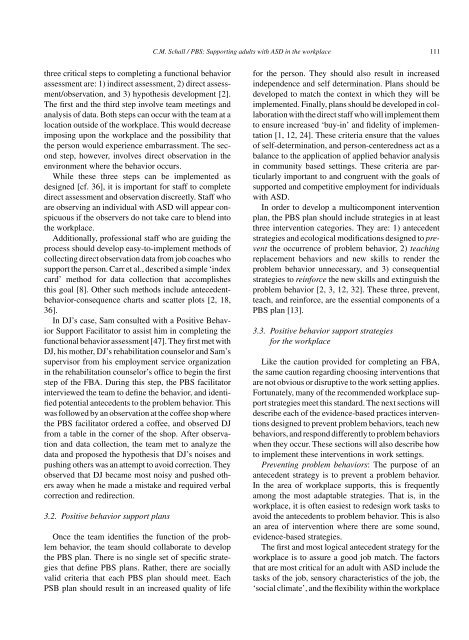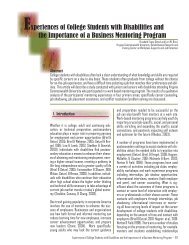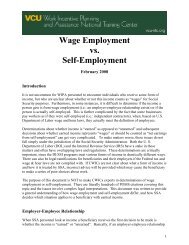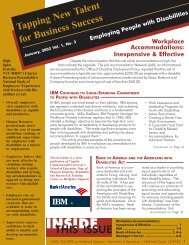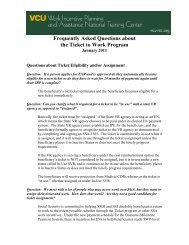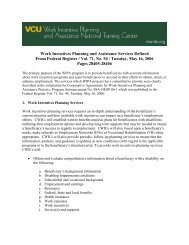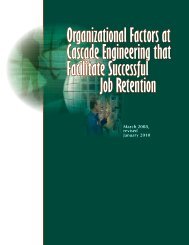Supporting adults with autism spectrum disorders in the ... - IOS Press
Supporting adults with autism spectrum disorders in the ... - IOS Press
Supporting adults with autism spectrum disorders in the ... - IOS Press
Create successful ePaper yourself
Turn your PDF publications into a flip-book with our unique Google optimized e-Paper software.
C.M. Schall / PBS: <strong>Support<strong>in</strong>g</strong> <strong>adults</strong> <strong>with</strong> ASD <strong>in</strong> <strong>the</strong> workplace 111three critical steps to complet<strong>in</strong>g a functional behaviorassessment are: 1) <strong>in</strong>direct assessment, 2) direct assessment/observation,and 3) hypo<strong>the</strong>sis development [2].The first and <strong>the</strong> third step <strong>in</strong>volve team meet<strong>in</strong>gs andanalysis of data. Both steps can occur <strong>with</strong> <strong>the</strong> team at alocation outside of <strong>the</strong> workplace. This would decreaseimpos<strong>in</strong>g upon <strong>the</strong> workplace and <strong>the</strong> possibility that<strong>the</strong> person would experience embarrassment. The secondstep, however, <strong>in</strong>volves direct observation <strong>in</strong> <strong>the</strong>environment where <strong>the</strong> behavior occurs.While <strong>the</strong>se three steps can be implemented asdesigned [cf. 36], it is important for staff to completedirect assessment and observation discreetly. Staff whoare observ<strong>in</strong>g an <strong>in</strong>dividual <strong>with</strong> ASD will appear conspicuousif <strong>the</strong> observers do not take care to blend <strong>in</strong>to<strong>the</strong> workplace.Additionally, professional staff who are guid<strong>in</strong>g <strong>the</strong>process should develop easy-to-implement methods ofcollect<strong>in</strong>g direct observation data from job coaches whosupport <strong>the</strong> person. Carr et al., described a simple ‘<strong>in</strong>dexcard’ method for data collection that accomplishesthis goal [8]. O<strong>the</strong>r such methods <strong>in</strong>clude antecedentbehavior-consequencecharts and scatter plots [2, 18,36].In DJ’s case, Sam consulted <strong>with</strong> a Positive BehaviorSupport Facilitator to assist him <strong>in</strong> complet<strong>in</strong>g <strong>the</strong>functional behavior assessment [47]. They first met <strong>with</strong>DJ, his mo<strong>the</strong>r, DJ’s rehabilitation counselor and Sam’ssupervisor from his employment service organization<strong>in</strong> <strong>the</strong> rehabilitation counselor’s office to beg<strong>in</strong> <strong>the</strong> firststep of <strong>the</strong> FBA. Dur<strong>in</strong>g this step, <strong>the</strong> PBS facilitator<strong>in</strong>terviewed <strong>the</strong> team to def<strong>in</strong>e <strong>the</strong> behavior, and identifiedpotential antecedents to <strong>the</strong> problem behavior. Thiswas followed by an observation at <strong>the</strong> coffee shop where<strong>the</strong> PBS facilitator ordered a coffee, and observed DJfrom a table <strong>in</strong> <strong>the</strong> corner of <strong>the</strong> shop. After observationand data collection, <strong>the</strong> team met to analyze <strong>the</strong>data and proposed <strong>the</strong> hypo<strong>the</strong>sis that DJ’s noises andpush<strong>in</strong>g o<strong>the</strong>rs was an attempt to avoid correction. Theyobserved that DJ became most noisy and pushed o<strong>the</strong>rsaway when he made a mistake and required verbalcorrection and redirection.3.2. Positive behavior support plansOnce <strong>the</strong> team identifies <strong>the</strong> function of <strong>the</strong> problembehavior, <strong>the</strong> team should collaborate to develop<strong>the</strong> PBS plan. There is no s<strong>in</strong>gle set of specific strategiesthat def<strong>in</strong>e PBS plans. Ra<strong>the</strong>r, <strong>the</strong>re are sociallyvalid criteria that each PBS plan should meet. EachPSB plan should result <strong>in</strong> an <strong>in</strong>creased quality of lifefor <strong>the</strong> person. They should also result <strong>in</strong> <strong>in</strong>creased<strong>in</strong>dependence and self determ<strong>in</strong>ation. Plans should bedeveloped to match <strong>the</strong> context <strong>in</strong> which <strong>the</strong>y will beimplemented. F<strong>in</strong>ally, plans should be developed <strong>in</strong> collaboration<strong>with</strong> <strong>the</strong> direct staff who will implement <strong>the</strong>mto ensure <strong>in</strong>creased ‘buy-<strong>in</strong>’ and fidelity of implementation[1, 12, 24]. These criteria ensure that <strong>the</strong> valuesof self-determ<strong>in</strong>ation, and person-centeredness act as abalance to <strong>the</strong> application of applied behavior analysis<strong>in</strong> community based sett<strong>in</strong>gs. These criteria are particularlyimportant to and congruent <strong>with</strong> <strong>the</strong> goals ofsupported and competitive employment for <strong>in</strong>dividuals<strong>with</strong> ASD.In order to develop a multicomponent <strong>in</strong>terventionplan, <strong>the</strong> PBS plan should <strong>in</strong>clude strategies <strong>in</strong> at leastthree <strong>in</strong>tervention categories. They are: 1) antecedentstrategies and ecological modifications designed to prevent<strong>the</strong> occurrence of problem behavior, 2) teach<strong>in</strong>greplacement behaviors and new skills to render <strong>the</strong>problem behavior unnecessary, and 3) consequentialstrategies to re<strong>in</strong>force <strong>the</strong> new skills and ext<strong>in</strong>guish <strong>the</strong>problem behavior [2, 3, 12, 32]. These three, prevent,teach, and re<strong>in</strong>force, are <strong>the</strong> essential components of aPBS plan [13].3.3. Positive behavior support strategiesfor <strong>the</strong> workplaceLike <strong>the</strong> caution provided for complet<strong>in</strong>g an FBA,<strong>the</strong> same caution regard<strong>in</strong>g choos<strong>in</strong>g <strong>in</strong>terventions thatare not obvious or disruptive to <strong>the</strong> work sett<strong>in</strong>g applies.Fortunately, many of <strong>the</strong> recommended workplace supportstrategies meet this standard. The next sections willdescribe each of <strong>the</strong> evidence-based practices <strong>in</strong>terventionsdesigned to prevent problem behaviors, teach newbehaviors, and respond differently to problem behaviorswhen <strong>the</strong>y occur. These sections will also describe howto implement <strong>the</strong>se <strong>in</strong>terventions <strong>in</strong> work sett<strong>in</strong>gs.Prevent<strong>in</strong>g problem behaviors: The purpose of anantecedent strategy is to prevent a problem behavior.In <strong>the</strong> area of workplace supports, this is frequentlyamong <strong>the</strong> most adaptable strategies. That is, <strong>in</strong> <strong>the</strong>workplace, it is often easiest to redesign work tasks toavoid <strong>the</strong> antecedents to problem behavior. This is alsoan area of <strong>in</strong>tervention where <strong>the</strong>re are some sound,evidence-based strategies.The first and most logical antecedent strategy for <strong>the</strong>workplace is to assure a good job match. The factorsthat are most critical for an adult <strong>with</strong> ASD <strong>in</strong>clude <strong>the</strong>tasks of <strong>the</strong> job, sensory characteristics of <strong>the</strong> job, <strong>the</strong>‘social climate’, and <strong>the</strong> flexibility <strong>with</strong><strong>in</strong> <strong>the</strong> workplace


